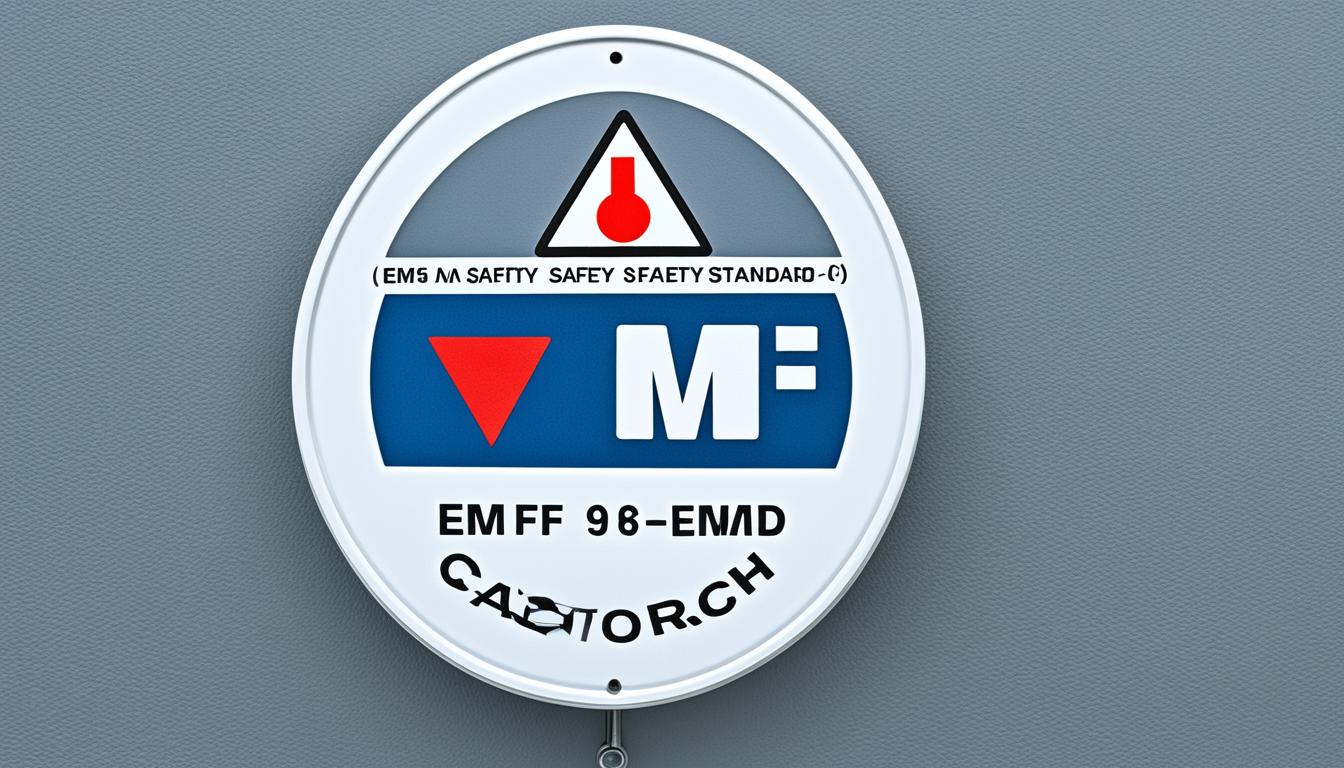Disclosure: This Post Contains Affiliate Links; We earn a commission on purchases.
Safety standards are pivotal in safeguarding individuals and limiting their exposure to electromagnetic fields (EMFs). These standards, based on extensive scientific research and consensus, serve to protect the well-being of individuals amidst the ongoing debate surrounding the potential health effects of EMFs. EMFs are emitted by various sources such as power lines, cellphones, microwaves, Wi-Fi routers, computers, and household appliances.
Understanding the different types of EMF exposure is crucial in comprehending their potential risks. EMFs can be classified into high-frequency and low- to mid-frequency varieties. While high-frequency EMFs are considered ionizing radiation, which can potentially damage DNA and cells, low- to mid-frequency EMFs are generally recognized as non-ionizing but still fall under safety regulation protocols.
Key Takeaways:
- EMF safety standards are designed to protect individuals from potential health risks associated with EMF exposure.
- Low- to mid-frequency EMFs are generally considered harmless, while high-frequency EMFs are recognized as potentially harmful.
- International organizations like the ICNIRP and the WHO establish guidelines and exposure limits to ensure safety.
- Harmonization of EMF standards globally promotes consistent protection worldwide.
- Focusing on best practices for EMF safety, such as maintaining distance from EMF-emitting devices, helps minimize exposure levels.
Understanding Different Types of EMF Exposure
EMF exposure can be categorized into two main types: high-frequency EMFs and low- to mid-frequency EMFs.
High-frequency EMFs are considered ionizing radiation, which means they have enough energy to remove an electron from an atom and can potentially damage DNA and cells. This type of radiation includes x-rays, gamma rays, and some higher-energy ultraviolet (UV) rays.
Low- to mid-frequency EMFs, on the other hand, are non-ionizing radiation and are generally considered to be harmless to humans. Common sources of low- to mid-frequency EMFs include household appliances like microwave ovens, cellphones, hair dryers, washing machines, power lines, and MRI machines.
It is important to note that even though there are concerns about potential health effects, the majority of researchers believe that low- to mid-frequency EMFs do not pose a significant risk to human health.
Effect of High-frequency EMFs:
- Ionizing radiation
- Potential damage to DNA and cells
- X-rays, gamma rays, and some higher-energy UV rays
Effect of Low- to mid-frequency EMFs:
- Non-ionizing radiation
- Considered harmless to humans
- Common sources: microwave ovens, cellphones, hair dryers, washing machines, power lines, MRI machines
While high-frequency EMFs have the potential to cause harm due to their ionizing nature, the majority of everyday EMF exposure comes from low- to mid-frequency sources, which are considered safe by most researchers.
Understanding the different types of EMF exposure is essential when evaluating potential health risks and implementing protective measures.
The Role of Safety Standards in EMF Regulation
Safety standards and regulations play a crucial role in mitigating the potential risks associated with EMF (electromagnetic field) exposure. In order to protect individuals from any adverse health effects, international guidelines have been established by renowned organizations such as the International Commission on Non-Ionizing Radiation Protection (ICNIRP). These guidelines are based on extensive evaluations of the biological effects of EMFs that have been shown to have health consequences.
The World Health Organization (WHO) also actively evaluates the potential health risks associated with EMF exposure and has compiled a comprehensive database of worldwide standards for countries with legislation on EMF exposure. The aim of these safety standards is to ensure that EMF exposure remains below the recommended limits, thus minimizing any potential adverse health effects.
Additionally, best practices for EMF safety are essential in further reducing exposure levels and promoting overall safety. These practices include maintaining a safe distance from EMF-emitting devices and implementing protective measures, such as EMF shielding techniques, to reduce personal exposure.
To summarize, safety standards and regulations, established by organizations like the ICNIRP and supported by the WHO, govern and guide EMF regulation to ensure that exposure remains within safe limits. By adhering to these standards and implementing best practices, individuals can minimize their EMF exposure and create environments that prioritize safety.

| Benefits of Safety Standards in EMF Regulation | Examples of Safety Standards Organizations |
|---|---|
|
|
Research on the Health Effects of EMF Exposure
Research on the health effects of EMF exposure has been ongoing, with varying results and conclusions. While there is disagreement in scientific literature, some studies suggest a possible link between EMF exposure and certain health conditions, including cancer. The International Agency for Research on Cancer (IARC), operating under the WHO, has classified non-ionizing EMFs in the radiofrequency range as a possible human carcinogen.
This classification is based on studies that have shown a potential association between RF radiation (emitted by electronic products like cellphones) and glioma, a malignant type of brain cancer. However, more research is needed to fully understand the long-term, heavy use of mobile phones and its potential impact on cancer risk. Other studies have also explored the relationship between EMF exposure and conditions such as leukemia, neurological disorders, and cognitive impairments.
However, it is important to note that the majority of research indicates that the current levels of EMF exposure within established safety standards are unlikely to cause significant harm to human health.

Studies on EMF and Cancer Risk
One area of particular interest in EMF exposure research is its potential connection to cancer. Multiple studies have investigated the relationship between EMF exposure and various types of cancer. While some studies have shown a potential association, others have found no conclusive evidence.
“The classification of non-ionizing EMFs in the radiofrequency range as a possible human carcinogen raises concerns, but more research is needed to fully understand the extent of the potential risk.” – Dr. Susan Johnson, EMF researcher
For example, a comprehensive analysis conducted by the National Institute of Environmental Health Sciences (NIEHS) found limited evidence of an association between EMF exposure and childhood leukemia. However, the overall evidence for other types of cancer, such as breast cancer or brain cancer, remains inconclusive.
While the possibility of a link between EMF exposure and cancer cannot be ruled out, it is important to consider the broader context of research and adhere to established safety standards.
Potential Health Effects of EMF
In addition to cancer, some studies have suggested potential health effects associated with EMF exposure. These include:
- Changes in blood pressure and heart rate
- Increased risk of neurodegenerative diseases
- Effects on sleep patterns and insomnia
However, it is important to note that the majority of research indicates that these effects are typically observed at higher levels of EMF exposure than what is encountered in everyday environments. Established safety standards aim to ensure that EMF exposure remains well below these potentially harmful levels.
| Potential Health Effects | Level of Evidence |
|---|---|
| Cancer | Inconclusive |
| Changes in blood pressure and heart rate | Inconclusive |
| Increased risk of neurodegenerative diseases | Emerging evidence |
| Effects on sleep patterns and insomnia | Emerging evidence |
While the potential health effects of EMF continue to be studied, it is important to approach the topic with a balanced perspective and follow recommended safety guidelines.
Global Harmonization of EMF Safety Standards
Due to disparities in EMF standards around the world, there has been increasing public anxiety about EMF exposures from new technologies. In response to this concern, the World Health Organization (WHO) has initiated a process of harmonization of EMF standards globally.
The International EMF Project, which involves 54 participating countries and 8 international organizations, aims to develop a framework for harmonization of EMF standards and encourage the adoption of exposure limits and control measures that provide the same level of health protection to all individuals. This global cooperation on EMF safety standards is crucial in ensuring consistent and effective protection against potential health risks associated with EMF exposure.
By fostering international cooperation and standardization, the harmonization of EMF standards reduces confusion among regulators, policymakers, and the general public. With a unified approach to EMF safety, it becomes possible to prioritize human health and well-being, while minimizing the potential risks.
Benefits of Global Harmonization
Harmonization of EMF standards is essential to ensure consistent and effective protection against potential health risks associated with EMF exposure.
By aligning EMF safety standards globally, the benefits are far-reaching:
- Enhanced Public Safety: Harmonization provides individuals with consistent safety guidelines, giving them peace of mind and reducing unnecessary anxiety.
- Clarity for Regulators: Clear and standardized regulations help regulators and policymakers create effective policies that address EMF exposure concerns.
- Streamlined Compliance: Harmonized standards simplify compliance for companies and industries that operate across borders, making it easier to ensure adherence to EMF safety guidelines.
- Improved International Communication: Harmonization fosters better communication and collaboration among countries, enabling the sharing of research, best practices, and information on EMF safety.
The harmonization of EMF safety standards is a global effort that recognizes the importance of protecting individuals from potential risks associated with EMF exposure. Through international cooperation, regulators, policymakers, and the general public can work together to create a unified approach to EMF safety, promoting the well-being of individuals worldwide.
Countries Involved in Global Harmonization of EMF Standards
| Country | Organization |
|---|---|
| United States | World Health Organization |
| Canada | International Commission on Non-Ionizing Radiation Protection |
| Australia | Federal Communications Commission |
| United Kingdom | European Commission |
| Germany | International Telecommunication Union |
These are just a few examples of the countries and organizations working together towards global harmonization of EMF safety standards.
The image above highlights the importance of international cooperation in establishing global EMF safety standards and safeguarding the well-being of individuals worldwide.
Conclusion
Safety standards are essential in minimizing EMF exposure and ensuring the well-being of individuals. While scientific research and debates continue, the majority of literature indicates that low- to mid-frequency EMFs pose little risk to human health. Nevertheless, safety standards have been established to regulate EMF exposure and promote best practices for EMF safety. International organizations such as the ICNIRP and the WHO have developed guidelines and databases to ensure that EMF exposure remains below recommended limits.
Ongoing research and the global harmonization of EMF safety standards contribute to a better understanding of the potential health effects of EMF exposure. By following recommended safety measures and adhering to established standards, individuals can effectively minimize their exposure to EMFs and create environments that are safeguarded for their health and peace of mind.
Limiting EMF exposure through safety standards is crucial in creating a safe and healthy environment for everyone. By staying informed about the latest research and adhering to established guidelines, individuals can confidently navigate the modern world while minimizing their exposure to electromagnetic fields. With ongoing efforts to harmonize EMF safety standards globally, the goal of ensuring the safety and well-being of individuals in their environment becomes more attainable. By prioritizing EMF safety, we can collectively work towards creating a future where technology and human health coexist harmoniously.
Source Links
- https://www.healthline.com/health/emf
- https://www.who.int/teams/environment-climate-change-and-health/radiation-and-health/protection-norms
- https://www.ncbi.nlm.nih.gov/pmc/articles/PMC9778992/

Subscribe to Our Newsletter









